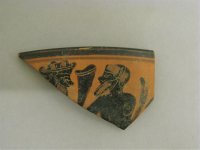



amphora
An item at Louvre
Decoration: on collar (side A and B); palmette and lotus flower (chain, double, alternating) on belly (top); tongues on belly (top, side A); amazonomachy; hoplite (2, helmet, cuirass, 1, chiton, short, 1, baldric, 1, scabbard, 1, greave, holding, shield, brandishing, spear, attacking); amazon (helmet, chiton, short, belt, greave, half-kneeling, holding, shield, indented, episema: thunderbolt, brandishing, spear); left and right; group (2); man (2, headband, beard, chiton, himation, holding, spear, near); woman (4, chiton, himation) on belly (top, side B); comos scene; comaste (5, beard, 2, necklace, 4, nude, dancing) on belly (in the middle); zone (3, surmounted by, fillet, 2, separated by, fillet); at the top; zone (palmette and lotus flower, chain, double, alternating); in the middle; zone of animals (mermaid, 4, confronted, sphinx, 2, panther, 4, ibex, 2, plant motif: palmette, lotus flower, opposite); at the bottom; zone of animals (doe, 3, alternating with, panther, 4) on belly (at the bottom); radiating edges (surmounted by, fillet) Condition of the work: incomplete; chips (mouthpiece, handle AB); lacunae (mouth, face B: right leg of the first hoplite, left leg of the amazon, second animal frieze and radiating ridges, face B: area under the first comast, in the radiating ridges on the right, around the handle BA) completed in plaster; concretions (mouth and belly face A); alteration of the red highlights; disappearance of the white highlights
Department of Greek, Etruscan and Roman Antiquities
An exhibit at Louvre
The Department of Greek, Etruscan, and Roman Antiquities is home to a collection of artworks representing the Greek, Etruscan, and Roman civilizations; it illustrates the art of a vast area encompassing Greece, Italy, and the whole of the Mediterranean basin, and spans the period from Neolithic times (4th millennium BC) to the 6th century AD.




